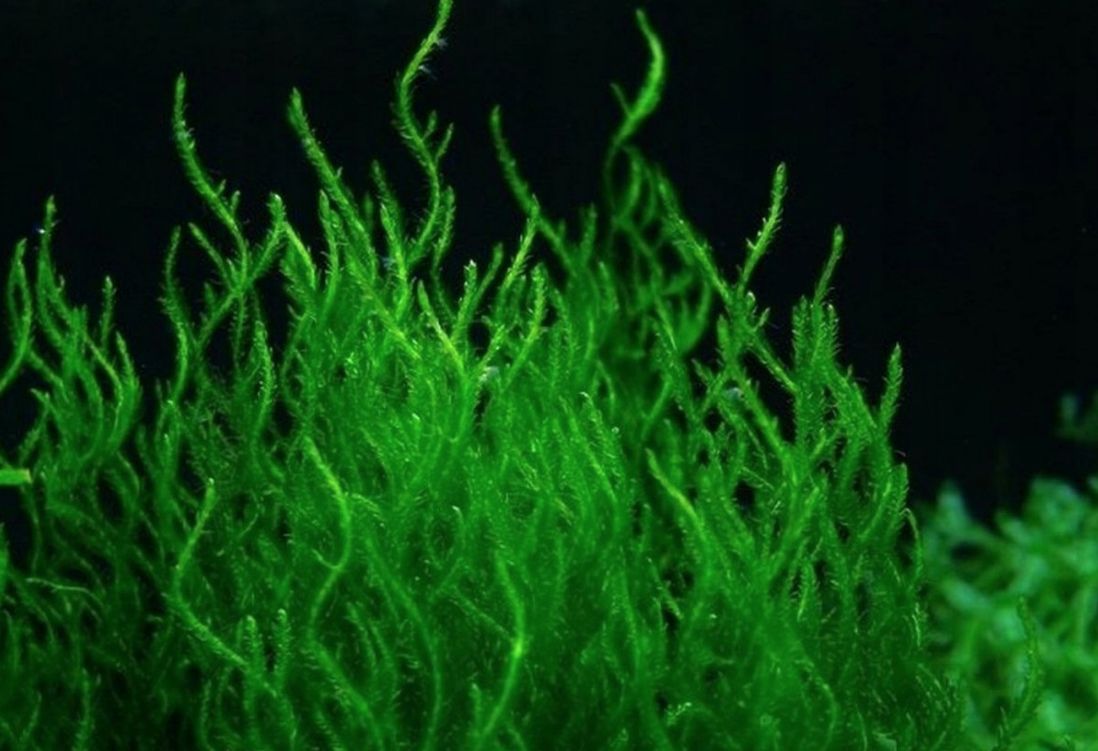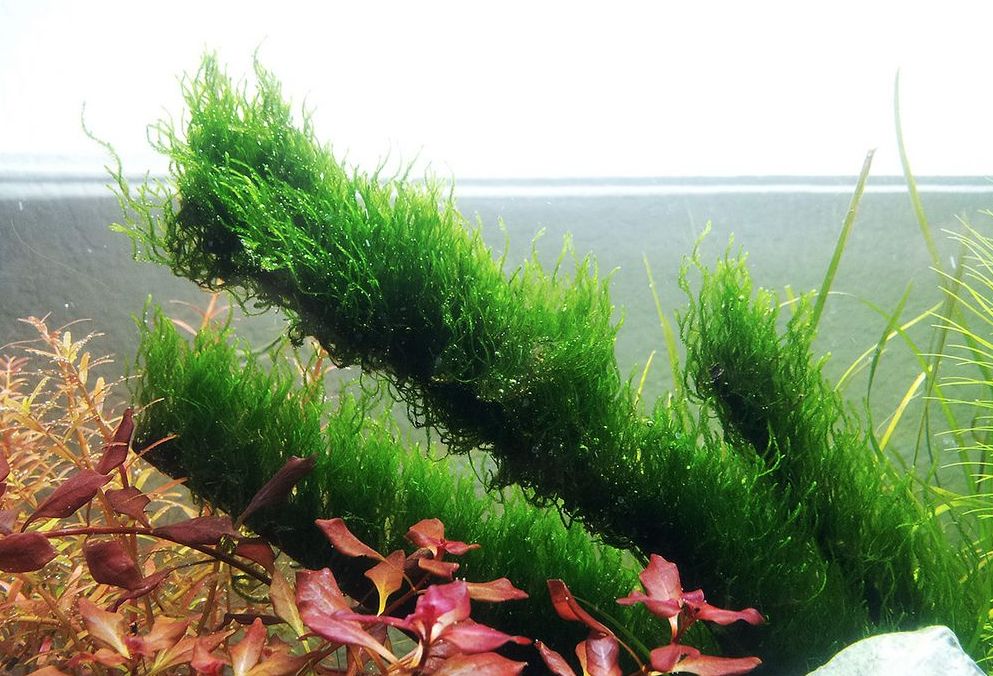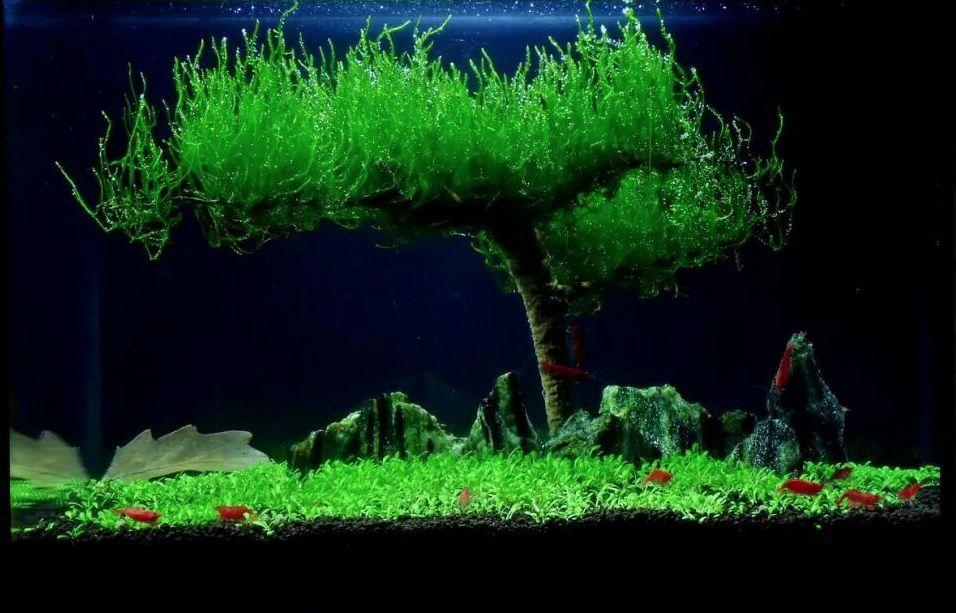Flame moss (Taxiphyllum sp. ‘Flame’) is the only known aquarium moss that grows its undulating shoots upwards. Bunches formed by this moss really resemble a flame, which makes it especially valuable in aquascaping. We should also mention that this moss has a bit darker green coloring, than that of the other aquarium mosses.

Contents
Habitat in the wild
South and South-East Asia are natural habitats of flame moss. Particularly in countries like Malaysia, Singapore, and Thailand. It grows in separate bushes in cool river water with slow flow. Flame moss can attach itself to various surfaces, including rocks, driftwood, and substrate. It does not require a specific type of substrate, but it will attach more easily and securely to rough surfaces. Flame moss is an epiphytic moss, meaning it grows attached to surfaces while obtaining nutrients from the water column. It does not have true roots but uses rhizoids to anchor itself.

Description
As a rule, it is considered that the moss grows horizontally in all directions and completely covers a surface with its bushes. It is true in most of the cases, however flame moss in some way breaks deeply-rooted patterns as for how mosses grow: it grows vertically upwards and its shoots may become about 4-6 inches long.
Though in a tank they usually don’t exceed 3 inches (8 cm). However, this moss grows widthway quite reluctantly. A distinctive feature of this aquatic flora representative, for sure, is its appearance: thick vertical shoots interlace and create a visual effect of a burning flame. However, this flame is a dark green one.
The plant has undeveloped root system. This moss gets nutrients from water and soil due to its numerous rhizoids – extremely thin filamentary outgrowths which the plant uses to stick to a substrate. Strong water flow easily tears the moss bunches from the ground or other substrate (a snag, for example).
| Feature | Description |
|---|---|
| Scientific Name | Taxiphyllum sp. ‘Flame’ |
| Common Names | Flame moss; fire moss |
| Origin | Southeast Asia, particularly Malaysia, Singapore, and Thailand |
| Growth Habit | Epiphytic moss that attaches to surfaces such as rocks and driftwood |
| Lighting | Tolerates a wide range of lighting conditions, from low to high light levels |
| Temperature | Thrives in temperatures between 20°C to 28°C (68°F to 82°F) |
| pH Level | Can adapt to a broad pH range, typically between 6.0 and 8.0 |
| Water Hardness | Tolerates both soft and hard water conditions |
| Water Flow | Prefers moderate water flow but can withstand gentle currents |
| Attachment | Attaches securely to surfaces using rhizoids |
| Habitat | Found in rivers, streams, and waterfalls in Southeast Asia |
| Biodiversity | Provides shelter and habitat for microorganisms, invertebrates, and fry |
| Aquascaping Use | Popular choice for creating natural and forest-like aquascapes |
| Maintenance | Low maintenance, requires occasional trimming and cleaning |
| Propagation | Can be propagated by dividing the moss or attaching fragments to surfaces |
| Difficulty Level | Beginner-friendly, suitable for aquarists of all experience levels |

Difficulties in keeping
All kinds of aquarium mosses are not demanding and flame moss isn’t an exception in this case. That’s why it won’t be challenging to grow this moss even for beginners. However, the moss will become more bushy if you improve its tank conditions by using some special fertilizers and additional CO2 supply.
You can also grow this moss without CO2 supply if the tank water has low hardness and pH level. If pH level is high, then it’ll be enough to supply CO2 into the tank just to decrease pH level at least to 7.5 value.
Small dosages of fertilizers will help you to improve moss appearance, though they aren’t a must.

Keeping in a tank and care
Flame moss has a relatively slow to moderate growth rate compared to some other aquatic plants. The growth rate can vary depending on the specific conditions provided in the aquarium.
Lighting
Provide moderate to high lighting levels for optimal growth. Use aquarium lights specifically designed for plant growth, ensuring a balanced spectrum that includes both red and blue wavelengths.
Water parameters
The plant feels perfectly well provided with water temperature about 20-28 °C. The water acidity (pH) almost doesn’t play any important part, therefore pH levels from 6 to 7.5 will do for the moss. It adapts well to both soft and hard water conditions. Ensure good water quality by performing regular water changes, removing debris, and monitoring ammonia, nitrate, and nitrite levels.
Water Flow
Moderate water flow is recommended to prevent debris buildup and keep the moss healthy. Avoid strong currents that may dislodge or damage the moss.
CO2
Flame moss (Taxiphyllum sp.) is a relatively low-demanding plant and can thrive without the addition of carbon dioxide (CO2) supplementation in the aquarium. It can grow well in setups without CO2 injection, especially if provided with adequate lighting and nutrient availability.
While CO2 injection can enhance the growth rate of some aquatic plants, including certain moss species, it is not typically necessary for the successful cultivation of Flame moss. The moss can adapt to a wide range of carbon dioxide levels found in most aquariums, utilizing dissolved carbon dioxide present in the water column.
How to plant flame moss
This moss doesn’t stick to substrates very well, that’s why aquarists attach it to the substrate, otherwise it floats away. You can stick it to snags, for example, with the help of colorless sea-line or a light colored cotton thread; the latter will gradually dissolve in the tank water just till the moss rhizoids get attached to the substrate.
To attach flame moss to the bottom horizontal surface a plastic net is used as a rule. You should place it flat on the area which you plan to decorate and carefully attach the moss bush to it by means of a transparent sea-line.
You can secure it using one of the following methods:
- Fishing Line: Use a fine, transparent fishing line to tie the moss onto the chosen surface. Wrap the line around the moss and the hardscape, making sure it is firmly attached but not too tight to damage the moss.
- Gel or Glue: Alternatively, you can use aquarium-safe glue or gel to attach the moss (like Super Glue). Apply a small amount of glue or gel to the attachment points on the hardscape and press the moss onto it. Allow the glue or gel to dry completely before placing the hardscape back into the aquarium.

Flame moss in aquascape
This moss is used to create middle distance and background decorations. Flame moss holds a specific place in aquascaping. It is often used to create images of forests, trees or just to draw attention to some specific elements of design in a tank.
Moss is in fact a perfect live ‘material’ in aquascaping. This not only due to its high decorative effect, but its plainness in care. Very often flame moss is planted on stones or wooden elements of the aquascape. This allows to move the ‘flame’ bush from one place to another depending on the tank owner design.
You can create an image of a bright green tree if you put a few bushes of the moss to a snag top.
After reaching its maximum height, this ornamental moss stays in the same condition for quite a long time. If you need to create a decorative effect of a forest in a tank, flame moss is the best option.
Since moss almost doesn’t grow widthway, you won’t have to thin it out for a long time and it doesn’t require any additional fertilization.
Sources: